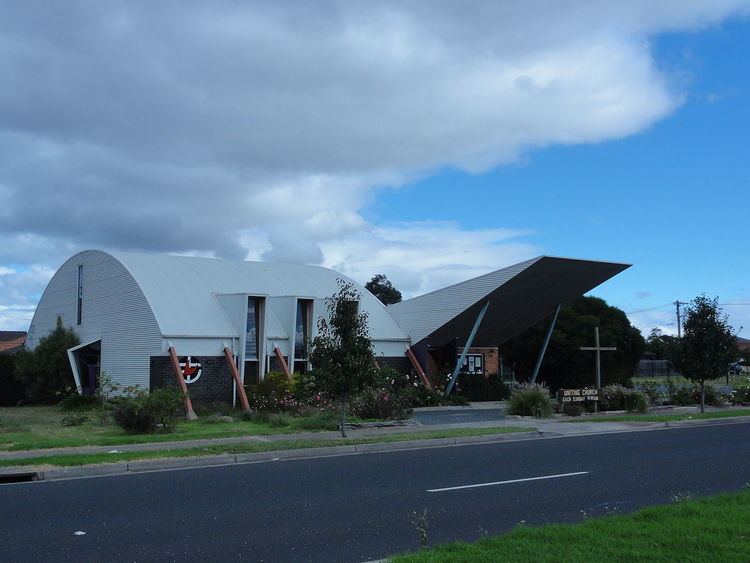Name Philip Harmer Role Architect | ||
 | ||
Philip Harmer is an Australian architect. He graduated from the University of Melbourne with a bachelor's degree in Architecture in 1976, and became a Fellow of the Royal Australian Institute of Architects (RAIA). Harmer has a strong appreciation for sculptural form and space that are powerfully shaped or wrought; thus, his works display the cleverness of how certain materials and details are used to represent his individual persona.
Contents
- Personal life
- Altona MeadowsLaverton Uniting Church 1993
- Wedge House 1999
- Darebin Arts Entertainment Center 1995
- Awards
- References
Personal life
Before Harmer enrolled in the Architecture program, he had worked for Yuncken Freeman Architects from 1972 to 1974. After graduating, he spent a few years working for Sidell Gibson Partnership Architects and JR Harris Architects in the United Kingdom. However, by 1980, Harmer was working for Buchan Laird & Buchan Architects before he developed his own company called Harmer Architecture in Collingwood, Australia. Until 2010 his company has won 14 RAIA awards. Harmer also holds a CASA private pilots license.
Harmer Architecture won the RAIA regional prize for the Esso BHP Billiton Wellington Entertainment Center in Sale, Victoria, Australia in 2004. With the aim to win this prize, their projects had to make noteworthy contributions to regional Victoria. Thus, their success led the jury to announce the importance of their development for the people of Sale. The jury also acknowledged that the company had, "…responded beyond the brief to provide an urban building that opens vistas and routes from the main road through to the historic but neglected Port of Sale."
Altona Meadows/Laverton Uniting Church 1993
In 1993, Harmer won his second RAIA award with the development of the monumental Altona Meadows/Laverton Uniting Church. The design of the building was inspired from an aircraft hangar because of the recognition of the aviation industry in Melbourne. The six curve-shaped iron pieces supports the main part of the building in which, "The curved roof form has been chosen for functional and economic reasons [where] the principal worship space is located centrally under the highest part of the roof with the secondary spaces grouped at each end..." There are also movable walls inside the building, which can create more open or closed spaces. According to Goad, Harmer’s choice of using bold shapes, strong colors and graphic structural expressions allows one to travel back to the structural-functional era when churches reflected postwar liturgical advances.
Wedge House 1999
After building the Wedge House in 1999, Harmer Architecture received both the Commendation for Outstanding Architecture award from the RAIA and the Winner Wools of New Zealand award from Interior Design Awards. Wedge House is one of Melbourne’s narrowest buildings with only 1.8 meters in width and 16 meters in length. The major materials used were concrete and rubber, but stainless steel linings and ionized copper sheets were also used for the main entrance door and windows. Rollo mentioned that the, "The two-storey house responds to the shape of the wedge in both plan and elevation [and] its design almost reflects seamlessly to a street scape of two-storey and single-storey Victorian homes and buildings."
This project recognizes Harmer’s hard work in challenging himself to construct a magnificent piece of architecture that is not only remarkable, but also practical enough to ensure that no space is wasted. For example, the office area is separated from the main bedroom by wardrobes, cupboards, and storage. The kitchen and bathroom are located on the narrowest ends of the first and ground floor; however, the free-standing stair wall would create an open slit between the floors making it appear more spacious. An interesting feature about this house is that the dining bench is built into one of the walls. Finally, the widest end of the first floor was made into a living room because the large glass walls that open to the west and south brings views of the city for family and friends to enjoy.
The Wedge House is currently home to an architect from one of Melbourne's leading architectural practices and his collection of bikes.
Darebin Arts & Entertainment Center 1995
The Darebin Arts & Entertainment Center was built with different parts to represent unique themes and functions of a variety of different programs. Therefore, this entertainment center can be used for multi purposes such as using it as a place for festivities or simply as a theater. It is worthwhile to mention that the "…the saw tooth roofs of the meeting rooms and studios refer to the industrial history of Preston [and the] theater is expressed as a colonnade of concrete fins from which the auditorium is suspended. This entertainment center was built along the axis running in the north-south direction on the site. The axis of the plan is designed on a 9 meter by 9 meter grid with arrangements of keeping the car park in mind. In addition, the axis is connecting to the Municipal Gardens behind the building.
